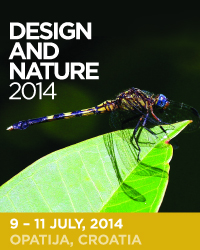Overview
The 7th International Conference on Comparing Design in Nature with Science and Engineering (Design and Nature 2014) has been held in Opatija, Croatia, organised by the Wessex Institute of Technology and sponsored by the International Journal of Design & Nature and Ecodynamics.
The conference started in Udine (2002) and since then has been reconvened in a series of locations around Europe, ie Rhodes (2004); The New Forest, home of the Wessex Institute (2006); the Algarve (2008); Pisa (2010) and A Coruña (2012).
Understanding nature has been a driving force for the research of many scientists and engineers since antiquity. They now have at their disposal a vast array of information for materials, mechanisms and control. They have arrived at sets of laws, products of analytical methods and observations which span from the atom level, leading to the understanding of the whole universe.
Leading thinkers have been inspired by the parallels between nature and human design. Nowadays, the huge increase in biological knowledge and developments in design and systems, together with the virtual revolution in computer power and simulation modelling, have made possible more comprehensive studies of nature.
The conference was opened by the Chairman, Prof Carlos A Brebbia, Director of Wessex Institute, who referred to the work of WIT and, in particular, it acting as a medium for the dissemination of knowledge. The conference series – Carlos said – is particularly appropriate for this as it brings people together from different locations around the world. Most of them are interdisciplinary meetings in which colleagues learn from each other in a friendly atmosphere.
The field of Design and Nature requires the collaboration of a wide range of scientists in order to better understand nature and learn from it.
Carlos also mentioned that the Institute covers a wide range of activities, in addition to research and training. Of particular importance are industrial research and publication of advanced books and journals.
It seems appropriate – Carlos said – in the case of this conference to refer to the Prigogine Medal which the Institute awards annually to renowned colleagues influenced by the work of Prigogine. This medal – established by the University of Siena and the Wessex Institute – started in 2004 to honour Prigogine’s memory and his association with the University of Siena’s Ecodynamics group and the fact that Prigogine was an Honorary Chairman of a WIT conference, as well as Honorary Editor of the Design and Nature Journal.
Carlos ended his remarks by thanking the delegates for coming and wishing them a very successful conference.
Keynote Address
The keynote address was given by Prof Giora Rosenhouse, until recently professor at the Technion Institute of Technology, and now director of his own company, Swantech, dedicated to sound wave analysis and technologies. The title of this presentation was “Colors of noise fractals and applications”, in which he described a wide variety of topics, ranging from deterministic to chaos analysis and the secrets of life!Conference Topics
The rest of the papers were classified under the following topics:- Mechanics in nature
- Natural materials and processes
- Biometrics and bio-inspiration
- Biological studies
- Natural energy behaviour
- Evolutionary physics
Social Occasions
The delegates had ample opportunities to hold informal discussions and get to know each other better. There were complimentary lunches arranged, in addition to the coffee breaks.An excursion was offered to visit the ancient city of Pula, the origins of which are pre-Roman. There have been human settlements there for at least the last five millennia, but the city architecture and culture has been influenced by the Romans and later the Venetians.
The most outstanding Roman remain in Pula is a large amphitheatre which could hold up to ten thousand spectators and is in reasonably good condition.
Several Roman temples are still standing in the main square as well as a beautiful Venetian building, housing the City government. Pula was an important trading port for the Romans and many reminders of that past are still dotted around the town.
The delegates had lunch in Pula, which was followed by a guided tour of the main places in town, ending in the amphitheatre museum.
The conference banquet was another occasion for the delegates to build stronger links. It consisted of a boat trip followed by a sit down dinner in beautiful surroundings.
The boat trip took the delegates around Opatija bay so that they could appreciate the hills, summer houses and hotels that cover the slopes and the shore. Then they had a glass of Spumante and some canapés.
Upon disembarkation the delegates were taken to a restored residence known for its paintings, prints and other works of art, and from there proceeded to the restaurant where the dinner was to take place. This was an old house, beautifully restored, facing the bay.
The dinner took place in a room whose walls were covered in paintings. There they had an outstanding meal consisting of Croatian specialities and accompanied by local wines and music of the region. The dishes included pasta, beef and home made ice cream.
The evening was most enjoyable and helped to consolidate the links between the participants.
Closing of the Conference
The conference was characterised by its friendliness and the high level of discussions. This is particularly important for a topic like Design and Nature that spans many different disciplines.The meeting was closed by Carlos, who expressed his appreciation to the members of the International Scientific Advisory Committee for their work in reviewing papers and to all attendees for their contribution. He referred to the possibility of publishing in the International Journal of Design and Nature, a unique forum for this type of research.
